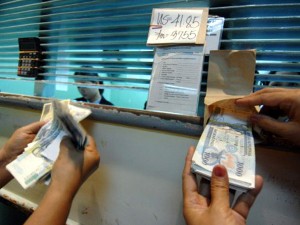MANILA, Philippines — Overseas remittance flows to the Philippines will likely expand at a faster pace of 8 to 8.5 percent in 2014 on improved global growth prospects and post-supertyphoon “Yolanda” (Haiyan) reconstruction, according to the British bank Standard Chartered.
In a research note dated January 13 written by analysts Jeff Ng and Robert Minikin, remittance flows in 2014 were said to grow by 2 to 2.5 percentage points over the 6 percent average growth in the first 10 months of 2013. This in turn has been seen to support a 6.7 percent gross domestic product (GDP) growth for the Philippines this year.
Stanchart expects the country’s GDP to return to the 7-percent growth pace by 2015 before easing to 6 percent in 2016.
Remittance flows have been projected to boost domestic spending and the country’s current account but Stanchart sees a muted impact on foreign exchange. The research note said benign global financial market conditions should lay the basis for a modest Philippine peso rebound later this year, with the peso seen ending 2014 at 43 against the US dollar.
The bank expects the peso to climb to 42 against the US dollar next year and further to 38.75:$1 by 2016.
Stanchart said the faster growth in remittances would be supported by a faster global expansion of 3.5 percent this in 2014 from 2.7 percent in 2013. The British bank said the Philippines would thus likely benefit from increased remittance inflows from two of its major sources – the US and Europe.
“Our models show a significantly strong relationship between nominal GDP (gross domestic product) growth and remittance growth from most countries, indicating that higher GDP growth will boost the income and remittance levels of overseas Filipinos,” the bank said.
“The Philippines is moving from being a consumption-led economy to one also driven by domestic investment. Nonetheless, overseas workers’ remittances remain an important component of the economy,” the report said.
Remittances constituted about 8.6 percent of Philippine GDP in 2012, less than the peak of 10.4 percent of GDP in 2006, but still higher than the 7.5 percent registered in 2005, the report noted.
“We believe that remittance growth will continue to translate into solid domestic household consumption that will underpin GDP growth,” the report said.
Increased remittances following Yolanda were also seen to have had a positive impact on remittance growth during the remainder of 2013 and in early 2014.
Stanchart expects this stronger remittance growth to support the current account surplus, although the goods trade deficit remains significant. It forecasts that the country’s current account would constitute 3.6 percent of GDP in 2013, higher than the 2.8 percent print in 2012.
